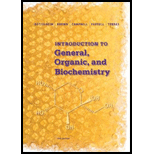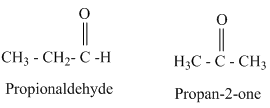
Concept explainers
17-9 Answer true or false.
(a) The one aldehyde and the one ketone with a molecular formula of C3H6O are constitutional isomers.
(b)
(c) The VSEPR model predicts bond angles of 1200 about the carbonyl carbon of aldehydes and ketones.
(d) The carbonyl carbon of a ketone is a stereocenter.
(a)
Interpretation:
Answer true or false for the following statement.
The one aldehyde and one ketone with a molecular formula of
Concept Introduction:
Constitutional isomers have the same molecular formula but different structural formulas or connectivity with atoms is different. In aldehydes, the carbonyl group is bonded to a hydrogen atom and ketones carbonyl group is bonded to two carbon atoms.
Answer to Problem 17.9P
The one aldehyde and one ketone with a molecular formula of
Explanation of Solution
The given molecular formula:
For this molecular formula we can draw both aldehyde and ketone. They are as follows.

From the above structures aldehydes and ketones having same molecular formula are constitutional isomers.
Therefore, the given statement is true.
(b)
Interpretation:
Answer true or false for the following statement.
Aldehydes and ketones both contain a carbonyl group.
Concept Introduction:
In aldehydes, the carbonyl group is bonded to a hydrogen atom and ketones carbonyl group is bonded to two carbon atoms.
Answer to Problem 17.9P
Aldehydes and ketones both contain a carbonyl group is true statement.
Explanation of Solution
In aldehydes, the carbonyl group is bonded to a hydrogen atom and in ketone carbonyl group is bonded to two carbon atoms. Hence, both an aldehyde and a ketone have a carbonyl group.

Where, R is an alkyl group.
Therefore, the given statement is true.
(c)
Interpretation:
Answer true or false for the following statement.
The VSEPR model predicts bond angles of 1200 about the carbonyl carbon of aldehydes and ketones.
Concept Introduction:
In aldehydes, the carbonyl group is bonded to a hydrogen atom and ketones carbonyl group is bonded to two carbon atoms. VSEPR model predicts the geometry of the molecule with the help of number of pair of electrons present around the central atoms and bond angle of the molecule.
Answer to Problem 17.9P
The VSEPR model predicts bond angles of 1200 about the carbonyl carbon if aldehydes and ketones is the true statement.
Explanation of Solution
In aldehydes, the carbonyl group is bonded to a hydrogen atom and ketones carbonyl group is bonded to two carbon atoms. The carbonyl group of aldehyde and ketone are represented are as follows.

According to VSEPR theory, three pair of electron groups forms a Trigonal planar geometry with bond angle of 1200.
Therefore, the given statement is true.
(d)
Interpretation:
Answer true or false for the following statement.
The carbonyl carbon of ketone is a stereocentre.
Concept Introduction:
A stereocentre is a tetrahedral carbon atom in which four different groups are attached to it. When an atom generally carbon is linked with four different groups, then that centre is known as chiral centre.
Answer to Problem 17.9P
The carbonyl carbon of ketone is a stereocenter is the false statement.
Explanation of Solution
In aldehydes, the carbonyl group is bonded to a hydrogen atom and in ketone carbonyl group is bonded to two carbon atoms. The carbonyl group of aldehyde and ketone are represented are as follows.

In ketones, the carbonyl carbon is boded to carbonyl oxygen by a double bond group and bonded to two other carbon atoms.
Therefore, the given statement is false.
Want to see more full solutions like this?
Chapter 17 Solutions
Introduction to General, Organic and Biochemistry
- 1. Part 1: Naming Organic Compounds он H₁C-C-CH3 CH3 Br CI CI 2. Br-CH-CH-CH₂ H₂C-CH-C= -CH-CH2-CH3 3. HC-CH-CH-C-OH 5. H₂C-CH-CH₂-OH 7. OH 4. CH CH₂-CH₂ 6. сно CH-CH-CH-CH₂-CH₂ H₁₂C-CH-CH-CH-CH₁₂-CH₁₂ 8. OHarrow_forward11 Organic Chemistry Organic Nomenclature Practice Name/Functional Group n-butane Formula Structural Formula (1) C4tt10 H3C C- (2) CH3CH2CH2 CH 3 H₂ -CH3 Н2 name & functional group (1) and (2) OH H₁₂C Н2 name only (1) and (2) name only (1) and (2) H₁C - = - CH₂ Н2 HC=C-C CH3arrow_forwardUnder aqueous basic conditions, nitriles will react to form a neutral organic intermediate 1 that has an N atom in it first, and then they will continue to react to form the final product 2: NC H₂O он- H₂O 1 2 OH Draw the missing intermediate 1 and the final product 2 in the box below. You can draw the two structures in any arrangement you like. Click and drag to start drawing a structure.arrow_forward
- Assign these COSY Spectrumarrow_forwardAssign these C-NMR and H-NMR Spectrumarrow_forwardPredict the product of this organic reaction: IZ + HO i P+H₂O Specifically, in the drawing area below draw the skeletal ("line") structure of P. If there is no reasonable possibility for P, check the No answer box under the drawing area. No Answer Click and drag to start drawing a structure. ☐ :arrow_forward
- Predict the products of this organic reaction: 0 O ----- A + KOH ? CH3-CH2-C-O-CH2-C-CH3 Specifically, in the drawing area below draw the condensed structure of the product, or products, of this reaction. (If there's more than one product, draw them in any arrangement you like, so long as they aren't touching.) If there aren't any products because this reaction won't happen, check the No reaction box under the drawing area. No reaction Click anywhere to draw the first atom of your structure. X ⑤ èarrow_forwardPredict the products of this organic reaction: O CH3 + H2O + HCI A A? CH3-CH2-C-N-CH3 Specifically, in the drawing area below draw the condensed structure of the product, or products, of this reaction. If there's more than one product, draw them in any arrangement you like, so long as they aren't touching. If there aren't any products because this reaction won't happen, check the No reaction box under the drawing area. No Reaction Click anywhere to draw the first atom of your structure.arrow_forwardWhat is the missing reactant in this organic reaction? R+ HO-C-CH2-CH3 0= CH3 CH3 —CH, C−NH—CH CH3 + H₂O Specifically, in the drawing area below draw the condensed structure of R. If there is more than one reasonable answer, you can draw any one of them. If there is no reasonable answer, check the No answer box under the drawing area. Note for advanced students: you may assume no products other than those shown above are formed. No Answer Click anywhere to draw the first atom of your structure. €arrow_forward
- 个 CHEM&131 9267 - $25 - Intro to Mail - Hutchison, Allison (Student x Aktiv Learnin https://app.aktiv.com Draw the product of the reaction shown below. Ignore inorganic byproducts. + Na2Cr2O7 Acetone, H2SO4 Type here to search Dryng OH W Prarrow_forwardPredict the products of this organic reaction: OH + NaOH A? Specifically, in the drawing area below draw the skeletal ("line") structure of the product, or products, of this reaction. (If there's more than one product, draw them in any arrangement you like, so long as they aren't touching.) If there aren't any products because this reaction won't happen, check the No reaction box under the drawing area. No reaction Click and drag to start drawing a structure. ✓ Sarrow_forwardPredict the products of this organic reaction: CH3-C-O-CH2-CH2-C-CH3 + H₂O ? A Specifically, in the drawing area below draw the condensed structure of the product, or products, of this reaction. (If there's more than one product, draw them in any arrangement you like, so long as they aren't touching.) If there aren't any products because this reaction won't happen, check the No reaction box under the drawing area. No reaction Click anywhere to draw the first atom of your structure. :☐ darrow_forward
 Chemistry: Principles and ReactionsChemistryISBN:9781305079373Author:William L. Masterton, Cecile N. HurleyPublisher:Cengage Learning
Chemistry: Principles and ReactionsChemistryISBN:9781305079373Author:William L. Masterton, Cecile N. HurleyPublisher:Cengage Learning Introduction to General, Organic and BiochemistryChemistryISBN:9781285869759Author:Frederick A. Bettelheim, William H. Brown, Mary K. Campbell, Shawn O. Farrell, Omar TorresPublisher:Cengage Learning
Introduction to General, Organic and BiochemistryChemistryISBN:9781285869759Author:Frederick A. Bettelheim, William H. Brown, Mary K. Campbell, Shawn O. Farrell, Omar TorresPublisher:Cengage Learning Chemistry & Chemical ReactivityChemistryISBN:9781133949640Author:John C. Kotz, Paul M. Treichel, John Townsend, David TreichelPublisher:Cengage Learning
Chemistry & Chemical ReactivityChemistryISBN:9781133949640Author:John C. Kotz, Paul M. Treichel, John Townsend, David TreichelPublisher:Cengage Learning Chemistry for Today: General, Organic, and Bioche...ChemistryISBN:9781305960060Author:Spencer L. Seager, Michael R. Slabaugh, Maren S. HansenPublisher:Cengage Learning
Chemistry for Today: General, Organic, and Bioche...ChemistryISBN:9781305960060Author:Spencer L. Seager, Michael R. Slabaugh, Maren S. HansenPublisher:Cengage Learning Chemistry & Chemical ReactivityChemistryISBN:9781337399074Author:John C. Kotz, Paul M. Treichel, John Townsend, David TreichelPublisher:Cengage Learning
Chemistry & Chemical ReactivityChemistryISBN:9781337399074Author:John C. Kotz, Paul M. Treichel, John Townsend, David TreichelPublisher:Cengage Learning




